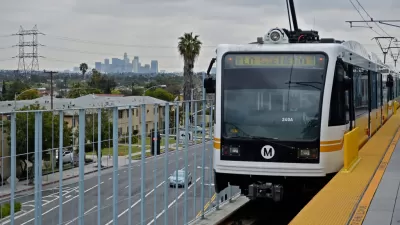Alissa Walker celebrates a historic day for rail transit in Los Angeles, as the $940 million, 8.6-mile first segment of the Expo Line opens to the public, leading the city "into a new transit era."
Walker discusses the joys, and shortcomings, of the new route, which once again connects the city's Westside to downtown along a historic rail right-of-way, and is expected to reach all the way to the beach in Santa Monica in only three years.
While the cars themselves are a bit of a disappointment, Walker has kind words for the station experience, designed by Los Angeles-based Parsons, with support from Gruen Associates and Miyamoto International. "The stations are elegant yet unassuming. Perforated metal sunshades undulate over simple steel tubing painted in a cool blue, which on most days is exactly the color of the LA sky. On the platforms, the canopies cast constantly changing shade patterns. Yet besides the digitized waves traced in the air, the infrastructure almost seems to disappear, allowing the framed views into the adjacent neighborhoods to become the visual focus of the stations."
And it's that distant view out from the stations that may be the most exciting aspect of the project for advocates of walkable urbanity, as Walker explains. "Neighborhoods along the way have already been preparing for the line's arrival, with transit-oriented developments dotting the route all the way to Santa Monica. The line could pave the way high quality urban development that could become a model for the city and the region."
FULL STORY: LA's Transit Dreams Coming True?

Alabama: Trump Terminates Settlements for Black Communities Harmed By Raw Sewage
Trump deemed the landmark civil rights agreement “illegal DEI and environmental justice policy.”

Planetizen Federal Action Tracker
A weekly monitor of how Trump’s orders and actions are impacting planners and planning in America.

The 120 Year Old Tiny Home Villages That Sheltered San Francisco’s Earthquake Refugees
More than a century ago, San Francisco mobilized to house thousands of residents displaced by the 1906 earthquake. Could their strategy offer a model for the present?

Ken Jennings Launches Transit Web Series
The Jeopardy champ wants you to ride public transit.

BLM To Rescind Public Lands Rule
The change will downgrade conservation, once again putting federal land at risk for mining and other extractive uses.

Indy Neighborhood Group Builds Temporary Multi-Use Path
Community members, aided in part by funding from the city, repurposed a vehicle lane to create a protected bike and pedestrian path for the summer season.
Urban Design for Planners 1: Software Tools
This six-course series explores essential urban design concepts using open source software and equips planners with the tools they need to participate fully in the urban design process.
Planning for Universal Design
Learn the tools for implementing Universal Design in planning regulations.
Clanton & Associates, Inc.
Jessamine County Fiscal Court
Institute for Housing and Urban Development Studies (IHS)
City of Grandview
Harvard GSD Executive Education
Toledo-Lucas County Plan Commissions
Salt Lake City
NYU Wagner Graduate School of Public Service





























